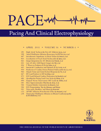Interatrial Conduction Correlates with Optimal Atrioventricular Timing in Cardiac Resynchronization Therapy Devices
Disclosure: This study was supported by Medtronic Inc., Cardiac Rhythm and Disease Management Division.
Abstract
Background: Echocardiographic optimization of the atrioventricular delay (AV) may result in improvement in cardiac resynchronization therapy (CRT) outcome. Optimal AV has been shown to correlate with interatrial conduction time (IACT) during right atrial pacing. This study aimed to prospectively validate the correlation at different paced heart rates and examine it during sinus rhythm (Sinus).
Methods: An electrophysiology catheter was placed in the coronary sinus (CS) during CRT implant (n = 33). IACT was measured during Sinus and atrial pacing at 5 beats per minute (bpm) and 20 bpm above the sinus rate as the interval from atrial sensing or pacing to the beginning of the left atrial activation in the CS electrogram. P-wave duration (PWd) was measured from 12-lead surface electrocardiogram, and the interval from the right atrial to intrinsic right ventricular activation (RA-RV) was measured from device electrograms. Within 3 weeks after the implant patients underwent echocardiographic optimization of the sensed and paced AVs by the mitral inflow method.
Results: Optimal sensed and paced AVs were 129 ± 19 ms and 175 ± 24 ms, respectively, and correlated with IACT during Sinus (R = 0.76, P < 0.0001) and atrial pacing (R = 0.75, P < 0.0001), respectively. They also moderately correlated with PWd (R = 0.60, P = 0.0003 during Sinus and R = 0.66, P < 0.0001 during atrial pacing) and RA-RV interval (R = 0.47, P = 0.009 during Sinus and R = 0.66, P < 0.0001 during atrial pacing). The electrical intervals were prolonged by the increased atrial pacing rate.
Conclusion: IACT is a critical determinant of the optimal AV for CRT programming. Heart rate-dependent AV shortening may not be appropriate for CRT patients during atrial pacing. (PACE 2011; 34:443–449)




